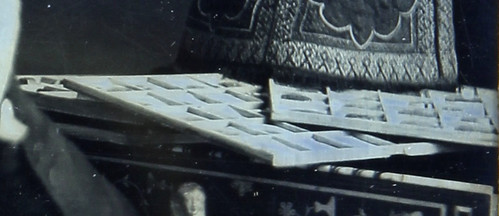
PREV ARTICLE
NEXT ARTICLE
FULL ISSUE
PREV FULL ISSUE
QUERY: 1840S COIN DEALER SEROVPE ALISHANNick Graver writes: A recently-met friend, Carlos G. Vertanessian of Argentina, has a fantastic daguerreotype portrait of an Armenian Dealer in Antiquities and Coins ‘probably’ made in “Italy or Paris, circa 1848.” The portrait shows him holding some antique pieces with what looks like coins in trays on the table behind. He is identified, from a very prominent family, and it is quite a wonderful image in all regards. Photography was only ten years in use, so this must be one of the most interesting identified early portraits of a numismatist.
Very interesting! Carlos kindly forwarded me a copy of a short article he wrote for The Daguerreian Annual 2013, Thank you! The
main text appears below along with an image of the photo. -Editor
The daguerreotype came with a handwritten poem by Father Alishan and contained a most inspiring message of hope, dedicated to his twin brother, the sitter, on their fiftieth birthday. The poem was written in ancient Armenian so I could not manage to read it, and sought help from the schoolmaster—another Mekhitarist father—after I purchased it. Along with the daguerreotype were some of the archeological and antique pieces that are shown in the portrait. A few of them I was able to purchase along with the image. You can see a collection of coins, on top of a Chinese Go game; a Persian fez-style hat; and some Egyptian figures. Also a Greek “tanagra” head can be seen lying on the table. Serovpe is holding a metal lion’s head—which I was able to purchase—and in his lower hand a Greek “tears-holder,” used in ancient Greece to collect the tears of a person in grief, and thus measure his pain. The lion might represent the strength or courage to overcome pain, represented by the Greek container. His elevated gaze and posture are most inspiring. So, of my collection, this is the undisputed masterpiece! I trust other members will agree it’s a unique occupational portrait of a fellow collector, and antiquarian, of a most unusual nationality.
Very interesting! Carlos also made this close-up image of the photo, showing the coin trays. -Editor

Many thanks to Carlos and Nick for making this rare early image available to us. So - what do numismatists have to say about this? Was
Serovpe Alishan known as a dealer outside his home country? Did he publish? Are there any known articles, price lists or auctions
associated with him? Any important coins whose pedigree includes his name? Anything the community can provide will be appreciated, and
perhaps provide material for a future article profiling him in more detail. Below is the complete caption for the photo and contact
information for Carlos. -Editor
"Artist Unknown. Serovpe Alishan. Armenian Antiquarian." Circa 1850. Sixth plate daguerreotype. Europe.Collection of Carlos G. Vertanessian, Buenos Aires, Argentina. daguerrotipia@gmail.com" 
Wayne Homren, Editor The Numismatic Bibliomania Society is a non-profit organization promoting numismatic literature. See our web site at coinbooks.org. To submit items for publication in The E-Sylum, write to the Editor at this address: whomren@gmail.com To subscribe go to: https://my.binhost.com/lists/listinfo/esylum All Rights Reserved. NBS Home Page Contact the NBS webmaster 
|
